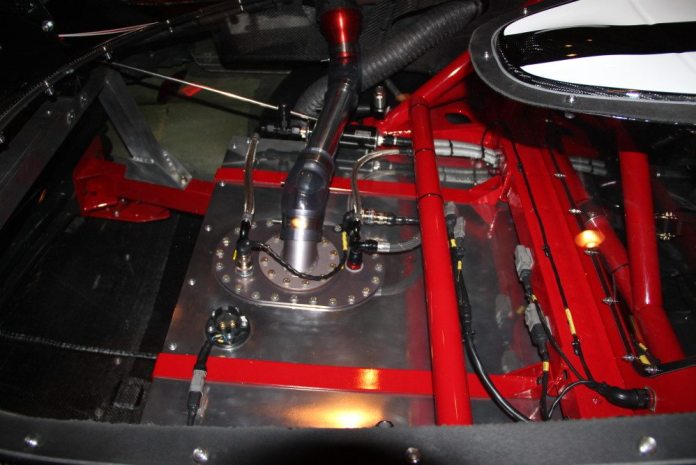
Dodge has done a pretty good job of making the production Viper as light as possible, but NASA Great Lakes member Scott Welham is taking weight savings to an even greater degree with his latest build, a 2013 model he bought used with less than a thousand miles on it. He took it to McCann Racing in Canton, Ohio, where they stripped all the factory panels and sent them out to be used to make molds for the carbon fiber panels that now are affixed to the space-frame chassis. The result? Welham’s Super Unlimited-class Viper weighs in at 2,870 pounds without a driver. A 2015 Dodge Viper TA 2.0 has a curb weight of 3,390 pounds. That is a 520-pound difference and it gets it below the magical 3,000-pound mark.

“McCann Racing is going to make this a vehicle people can purchase,” Welham said. “I’m just the first guy to develop it with them. They made molds for the carbon fiber and they will have the ability to make more cars and make spare parts – not that anyone’s ever going to hit me, right?” If anyone can catch him, that is. The one area where they didn’t factor in weight considerations was when they installed the air-jack system on the car. But that’s not for the driver, really, as much as it is for the crew.

“I tell the guys we could take that out and save a lot of weight, and they tell me no we can’t,” Welham said. “As much as they do for me I can’t argue with them.” Welham’s old 2005 Viper Comp Coupe ran an Emco transmission. In that car, he set STR1 track records at Mid-Ohio SportsCar Course and Putnam Park and scored a National Championship in ST1 at Mid-Ohio in 2012. “We’ve used the Emco transmission for years,” Welham said. “I know it’s a good transmission. I also know it’s very hard on the rear end, and so we have to watch what we’re doing with the rear end to make sure we don’t break the half shafts. The old car had hollow shafts, so we had to go with solid shafts.”

In the new car, he’s again using the Emco gearbox, but this time it will be paddle-shifted, which allows the team to tailor the shifts with software, yet still have that nice bulletproof transmission under the car to handle the Viper’s massive power output.

Welham and McCann pondered switching to a different chassis, but they chose the Viper because it’s a car they know well. In the new car, Welham and McCann Racing took everything they had learned from racing Vipers for decades and put all that knowledge to work in building the new car.

“We had a discussion about what car to replace that burgundy car with, the 2005 comp coupe,” Welham said. “We looked at Porsches and Cup cars and that kind of stuff and kind of came back to the idea that we’re Viper guys. We’ve been Viper guys for years and we were going to go ahead and do this, particularly since Dodge has no plans at this point to put out a competition coupe. So he thought it would be a good idea to have an affordable racecar for guys to run. “We found the flaws and the areas where we could improve the Viper, so in this car we fixed everything we knew that was a problem … when we updated or fixed them on this car,” Welham said. “It was our opportunity to do the thing right. That’s what drove us to the Viper. If we had started with a Porsche, we’d have to learn the car. The nuances are typically the things that get you much, much better, right? You know what things have to be improved, so that’s what drove us to do this.”

The project got the green light late in 2013 and the project has been in the works for a year and a half to get the car track-ready. They need to get the car on track and sorted before they debut it at the NASA Great Lakes event at Mid-Ohio in June. The team arrived at using Brembo brakes front and rear and going with Penske triple-adjustable shocks. Throughout their years of racing Vipers, those are what they found to work best. Front brakes are six-piston monoblock calipers, with four-piston monoblock binders in the rear. For data, they went with OBR Electronics and a Motec system with a C125 display atop the steering column. The engine is a GT3 spec 8.4-liter V-10 that has been enhanced with a Comp cam, a Dailey dry-sump oiling system and Belanger headers. The end result is a stunning full-body car that should hang with the low-slung sports racers that populate Super Unlimited. It’s probably lighter than any Viper has an right to be, assembled with impeccable build quality. “I’m looking forward to getting it on the track to make sure it runs well,” Welham said. “I’m real excited about it. It’s been a long time coming.”
|
Owner: |
Scott Welham |
|
Year: |
2013 |
|
Make: |
Dodge |
|
Model: |
Viper |
|
Weight: |
2,870 lbs. w/o driver |
|
Engine: |
8.4-liter V-10 |
|
Transmission: |
EMCO paddle-shifted sequential |
|
Suspension: |
Front: Coil-overs with monoball control arms, Penske triple-adjustable shocks Rear: Coil-overs with monoball control arms, Penske triple-adjustable shocks |
|
Tires: |
Front: Hoosier 320-650R-18 Rear: Hoosier 355-650R-18 |
|
Brakes: |
Front: Brembo monoblock, six piston Rear: Brembo monoblock, four piston |
|
Data system: |
Motec with C125 display |
|
Sponsors: |
McCann Racing, Arrow Racing Engines, Forgeline Wheels, OBR Electronics, Penske Racing Shocks, Brembo Brakes, Block A Chip |
























